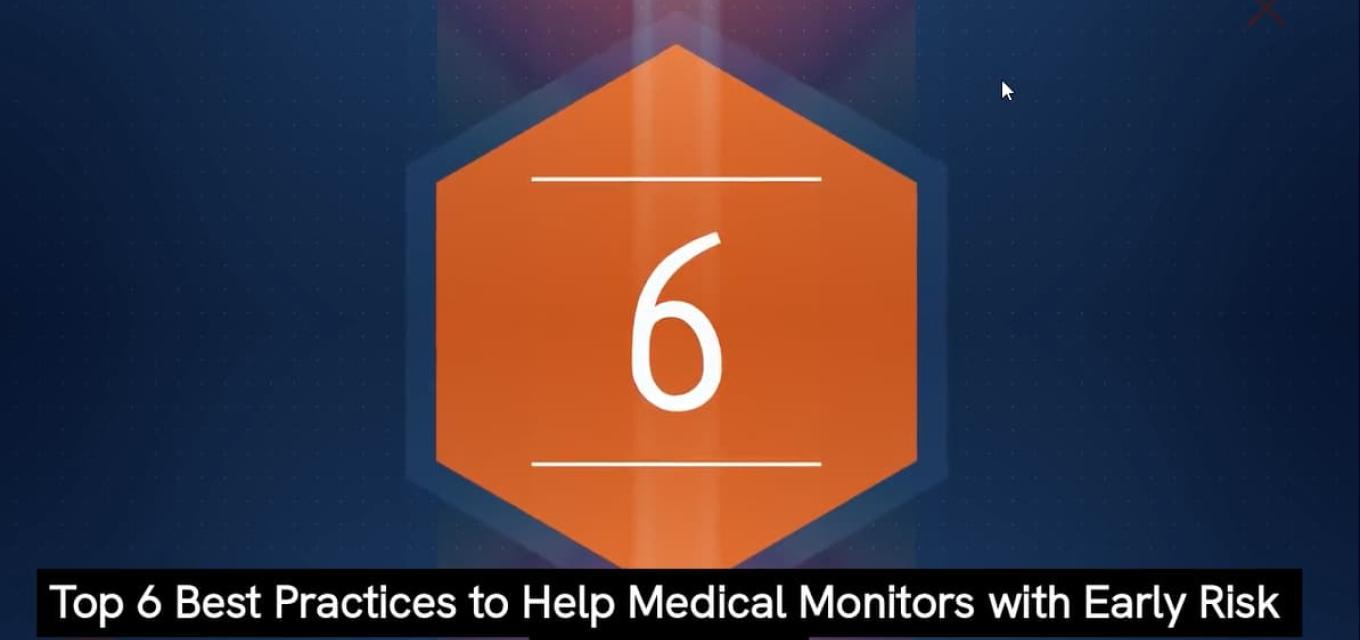Top 6 Best Practices to Help Medical Monitors with Early Risk Identification
The vast majority of clinical trials have a medical monitor, but the role looks very different now than in decades past. Medical monitors first and foremost keep study patients safe. But they traditionally worked retrospectively, once data was compiled and scrubbed near the very end of the trial.
The role continues to evolve. New methodologies reflect the integration of electronic data capture and cutting-edge tech, intended to more quickly and productively analyze data and maintain data integrity. This ability to review data in-stream opened the possibility of course-correcting midstream.
Success today for medical monitors depends on leveraging dedicated software solutions in order to work with data in flight. In order to use analytics and visualizations to identify risks early enough to improve patient safety during trials, here are six best practices for medical monitors.
1) Ensure Near Real-Time Access to Clinical Trial Data that is Ready For Analysis.
Medical monitors need near-real-time data to help them in their critical role to identify risks early and enable patient safety in clinical trials. But many medical monitors are forced to spend too much time gathering and preparing data, and too little time analyzing it.
Using an effective SaaS clinical analytics solution can improve the efficiency of medical monitors. Having access to aggregated and standardized in-stream data saves clinical trials millions of dollars per year, but is most actionable when it can be visualized and then properly explored. That’s why Revvity Signals developed Signals Clinical which integrates with industry-leading Spotfire® for visualization of near-real-time clinical data.
2) Tailor Your Clinical Data Review Workflow for Your Specific Therapy.
Long gone are the days when a manual approach would be sufficient for accessing and aggregating the siloed clinical data sources that must be integrated for risk and safety analysis by medical monitors. Instead, the most efficient approach to clinical analysis utilizes platforms optimized for both speed and agility, allowing for tailored workflows. The goal of such flexibility is to meet the needs of both the trial and medical monitor.
The priorities for a tailored workflow include:
-
reduce the risks to patients and trial outcomes
-
streamlined data provisioning, aggregation, and review in a centralized solution
-
strong data visibility for numerous disparate sources
-
rapidly address inquiries, especially in response to regulators
-
innovative visual analytics and workflow capabilities
-
fast risk identification, which potentially leads to cost savings.
Signals Clinical is an end-to-end clinical data science solution that enhances study data quality, patient safety, and operational insights through real-time data access, robust self-service analytics, and traceable decisions. Signals Clinical delivers traceable decisions directly within your visualizations and workflows.
3) Quickly Focus on What is Most Important.
Having analytics-ready clinical data is a necessity. But timely access to the right data at the right time can drive crucial decision making in drug development. Without it, the consequences of delayed access to time-sensitive data can include missed safety signals, increased risk to patients and the study, and wasted time and money.
Meanwhile, medical monitors can’t be expected to be both clinical specialists and data specialists. The right analytics tool actively delivers the information medical monitors need for the specifics of their trial, with the right visualizations and workflows to streamline the efficiency of their review.
4) Organize Workflows with Population-to-Subject to Line-Listing Drill-Down Capability.
The best analytical tools enable medical monitors to drill down into data in order to properly investigate causes and relationships. That requires workflows that can implement certain capabilities and be easily adapted for varying protocols and therapeutic areas.
For example, Signals Clinical enables the medical review of adverse events by users starting from a population view of reported data, then digging deeper for detailed analysis down to the patient level. While exploring, medical monitors can drill further down for additional detail based on criteria including organ system, concurrent medications and severity, as well as combinations, as needed.
5) Track Review Process and Record Comments
Clinical trials today generate exponentially more data than in years past. Manually identifying patterns, trends, and outliers in spreadsheets and listings today would mean parsing thousands of lines across multiple spreadsheets. Medical monitors needed a better way to find potential safety signals in the data haystacks. The right analytics tool makes it easy to move between visualizations and line listings and create notes, highlight data issues, or even submit queries in line with your analyses.
6) Collaborate to Track Data Reviewed, and Keep a Record of Actions or Requests
Stakeholder collaboration is key to clinical trials, requiring a centralized analytics solution to help teams quickly uncover safety insights – especially given the various data sources that may be required for analysis. Utilize a platform, such as Signals Clinical, that’s fast, scalable and flexible that provides a library of prebuilt clinical visualizations and integration with Spotfire for custom visualizations.
If you’re looking for a clinical analytics solution that ticks all of the boxes, helping you ensure safety for the patients enrolled in your trial, take a look at how Signals Clinical can meet all of your needs.

Mark Weadon
Clinical Analytics Product Marketing ManagerMark Weadon has been active in clinical development analytics and visualization for over 20 years. Mark currently serves as the Clinical Analytics Product Marketing Manager at Revvity Signals. Mark has thirteen years of pharmaceutical industry experience at GlaxoSmithKline. Mark pivoted into life sciences product marketing with roles at SAS Institute, IBM, Definitive Healthcare, and Revvity Signals. Mark holds an MBA from Elon University and a BA from Duke University.
